FabulousFusionFood's Spice Guide for Chilli Home Page
 Green finger
chillies (left) and
red chilli powder
(right).
Green finger
chillies (left) and
red chilli powder
(right).
Welcome to the summary page for FabulousFusionFood's Spice guide to Chilli along with all the Chilli containing recipes presented on this site, with 2919 recipes in total.
This is a continuation of an entire series of pages that will, I hope, allow my visitors to better navigate this site. As well as displaying recipes by name, country and region of origin I am now planning a whole series of pages where recipes can be located by meal type and main ingredient. This page gives a listing of all the spice-based recipes added to this site.
These recipes, all contain Chilli as a major flavouring.
Chillies (also known as Chili, Chilé and Ají) are the fruit of the Capsicum members of the Solanaceae (deadly nightshade) family. The name itself is derived from Nahuatl (Aztec) language via the Spanish chilé. They all originate in the Americas, where they have been cultivated for at least 7500 years, though because of their culinary uses they are now grown all over the world. Christopher Columbus encountered them on his first voyage to the Caribbean in 1492 and though he did not bring any back on that voyage (they were taken to Spain on his second voyage) he does write of a 'pepper' that the natives called Ají which was better in taste and nature that ordinary peppers. Wanting to prove that he had opened a new easterly route to the Indies Columbus was keen to associate Ají with Asian 'pepper'. From Mexico, at the time the Spanish colony that controlled commerce with Asia, chilli peppers spread rapidly into the Philippines and then to India, China, Korea and Japan with the aid of European sailors. The new spice was quickly incorporated into the local cuisines. It seems to have entered India via the Portuguese colony of Goa before journeying northwards through Central Asia and Turkey, to Hungary, where it became the national spice in the form of paprika (central image, left).
Numerous cultivars of the Capsicum plant exist and these range from Capsicum annuum, which includes many common varieties such as bell peppers, paprika, jalapeños, and the chiltepin; Capsicum frutescens, which includes the cayenne and tabasco peppers; Capsicum chinense, which includes the hottest peppers such as habañeros and Scotch bonnets; Capsicum pubescens, which includes the South American rocoto peppers and Capsicum baccatum, which includes the South American ají peppers.
Chilli peppers add both flavour and 'heat' to a dish. The heat being produced by capsaicin (8-methyl-N-vanillyl-6-nonenamide) and several related chemicals, collectively called capsaicinoids. These are hydrophobic (water-hating) chemicals and this is why they tend to bury themselves into the surfaces of the palate and the mouth causing irritation (the burning sensation; indeed the chemical is produced by the plants to deter predation by animals). This is also why drinking water is ineffective as a way of eliminating the burning sensation. The capsaicinoids do not dissolve in water and are simply spread by it. However, foods rich in fat such as milk and yoghurt will eliminate the chemical (this is why yoghurt is served with many Indian dishes).
The 'heat' of foods is measured by special units, called Scoville units. Bell peppers rank at zero Scoville units, jalapeños at 3,000–6,000 Scoville units, and habaneros at 300,000 Scoville units. The current official Guinness Book of Records record for the highest Scoville rating for a chilli pepper goes to the Red Savina Habanero, measuring 577,000 units. Reports of a hotter pepper have circulated for many years, though and a recent report was made of a pepper from India called the Naga Jolokia measuring at 855,000 Scoville units but the validity of this claim is disputed. However, in April 2006 a report of the Naga Dorset pepper, a variety of the Naga Jolokia pepper cultivated exclusively by the Peppers by Post company in Dorset, England who claimed their pepper measured 923,000 SHU [note that pure capsaicin rates at 15,000,000 Scoville units] (though this has now been displaced by the Carolina Reaper). Within the Chilli fruit itself, it is the stem end of the pod that contains the glands that produce the capsaicin, which then flows down through the pod. Removing the seeds and inner membranes is thus effective at reducing the heat of a pod.
Korean, Indian, Indonesian, Szechuan and Thai cuisines are particularly associated with the chilli pepper, although the plant was unknown in Asia until Europeans introduced it there. Dried red chilli (red, bottom) is a common ingredient in many Indian dishes and is also used, along with cumin and other spices to create Chilli Con Carne.
They probably became an essential component of the Mesoamerican diet (which relied on maize and beans as a staple) as the high vitamin C content of red chilli peppers increase the uptake of non-haeme iron in diets containing little or no meat.
If you are interested in chillies and the history of this spice, then why not reald my page on the The Global Spread of Chillies from the New World to the Old World. Find out how and why chillies spread from Brazil to Europe, Africa and Asia in just 50 years between 1498 and 1549.
This is a continuation of an entire series of pages that will, I hope, allow my visitors to better navigate this site. As well as displaying recipes by name, country and region of origin I am now planning a whole series of pages where recipes can be located by meal type and main ingredient. This page gives a listing of all the spice-based recipes added to this site.
These recipes, all contain Chilli as a major flavouring.
Chillies (also known as Chili, Chilé and Ají) are the fruit of the Capsicum members of the Solanaceae (deadly nightshade) family. The name itself is derived from Nahuatl (Aztec) language via the Spanish chilé. They all originate in the Americas, where they have been cultivated for at least 7500 years, though because of their culinary uses they are now grown all over the world. Christopher Columbus encountered them on his first voyage to the Caribbean in 1492 and though he did not bring any back on that voyage (they were taken to Spain on his second voyage) he does write of a 'pepper' that the natives called Ají which was better in taste and nature that ordinary peppers. Wanting to prove that he had opened a new easterly route to the Indies Columbus was keen to associate Ají with Asian 'pepper'. From Mexico, at the time the Spanish colony that controlled commerce with Asia, chilli peppers spread rapidly into the Philippines and then to India, China, Korea and Japan with the aid of European sailors. The new spice was quickly incorporated into the local cuisines. It seems to have entered India via the Portuguese colony of Goa before journeying northwards through Central Asia and Turkey, to Hungary, where it became the national spice in the form of paprika (central image, left).
Numerous cultivars of the Capsicum plant exist and these range from Capsicum annuum, which includes many common varieties such as bell peppers, paprika, jalapeños, and the chiltepin; Capsicum frutescens, which includes the cayenne and tabasco peppers; Capsicum chinense, which includes the hottest peppers such as habañeros and Scotch bonnets; Capsicum pubescens, which includes the South American rocoto peppers and Capsicum baccatum, which includes the South American ají peppers.
Chilli peppers add both flavour and 'heat' to a dish. The heat being produced by capsaicin (8-methyl-N-vanillyl-6-nonenamide) and several related chemicals, collectively called capsaicinoids. These are hydrophobic (water-hating) chemicals and this is why they tend to bury themselves into the surfaces of the palate and the mouth causing irritation (the burning sensation; indeed the chemical is produced by the plants to deter predation by animals). This is also why drinking water is ineffective as a way of eliminating the burning sensation. The capsaicinoids do not dissolve in water and are simply spread by it. However, foods rich in fat such as milk and yoghurt will eliminate the chemical (this is why yoghurt is served with many Indian dishes).
The 'heat' of foods is measured by special units, called Scoville units. Bell peppers rank at zero Scoville units, jalapeños at 3,000–6,000 Scoville units, and habaneros at 300,000 Scoville units. The current official Guinness Book of Records record for the highest Scoville rating for a chilli pepper goes to the Red Savina Habanero, measuring 577,000 units. Reports of a hotter pepper have circulated for many years, though and a recent report was made of a pepper from India called the Naga Jolokia measuring at 855,000 Scoville units but the validity of this claim is disputed. However, in April 2006 a report of the Naga Dorset pepper, a variety of the Naga Jolokia pepper cultivated exclusively by the Peppers by Post company in Dorset, England who claimed their pepper measured 923,000 SHU [note that pure capsaicin rates at 15,000,000 Scoville units] (though this has now been displaced by the Carolina Reaper). Within the Chilli fruit itself, it is the stem end of the pod that contains the glands that produce the capsaicin, which then flows down through the pod. Removing the seeds and inner membranes is thus effective at reducing the heat of a pod.
Korean, Indian, Indonesian, Szechuan and Thai cuisines are particularly associated with the chilli pepper, although the plant was unknown in Asia until Europeans introduced it there. Dried red chilli (red, bottom) is a common ingredient in many Indian dishes and is also used, along with cumin and other spices to create Chilli Con Carne.
They probably became an essential component of the Mesoamerican diet (which relied on maize and beans as a staple) as the high vitamin C content of red chilli peppers increase the uptake of non-haeme iron in diets containing little or no meat.
Capsicum annuum
This encompasses one of the largest species in the capsicum genus and includes everything from the bell pepper (which has no heat) to the Thai birds-eye chilli with a heat rating of between 80 000–150 000 Scoville Heat Units. Typical hot members of this species include: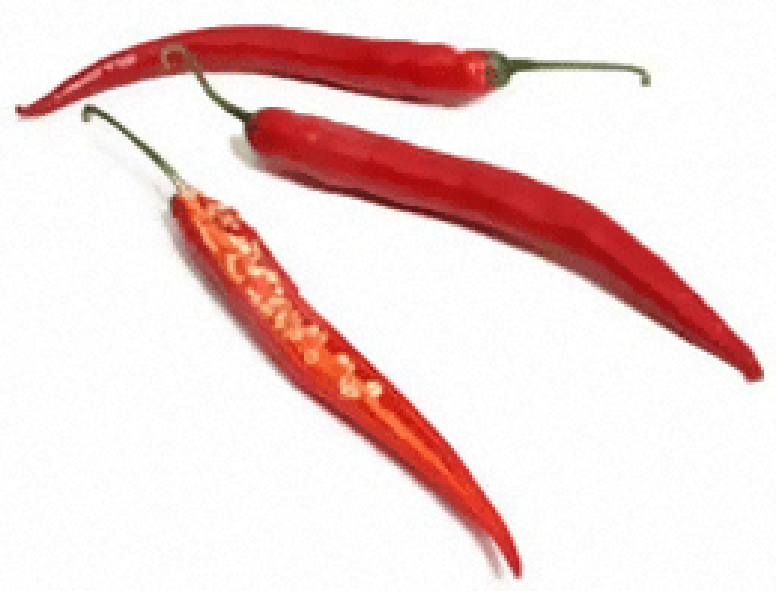 Cayenne Pepper is a long thin Chilli which has only moderate heat (30 000–50 000 Scoville Heat Units) which is the commonest form of chilli seen in the UK. It was originally transported by the Chines to China and India, where it is used widely. This chilli is also often dried and ground into powder and Cayenne pepper as the powder is known is a staple of many store cupboards. |
 The Jalapeño Pepper is one of the classic chilli types. It is only of low heat (2 500–30 000 Scoville Heat Units) but is very popular in its pickled form as a condiment. Pickled, sliced, jalapeños are often used on pizzas. The smoke-dried form jalapeño is known as a chipotle and is very popular in South American cuisine. |
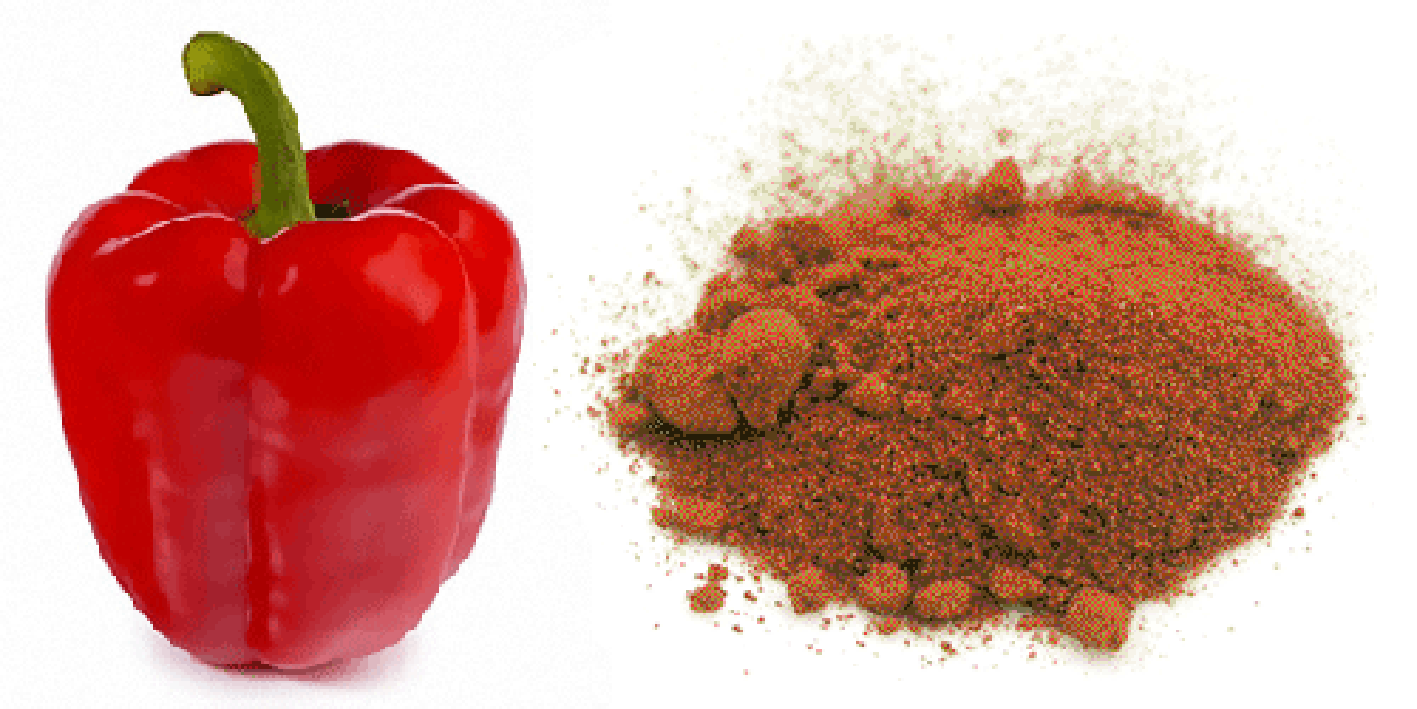 Though derived from the Hungarian word for 'pepper' Paprika tends now to be used as a term to refer to a flavourful red spice derived from dried paprika chilli pods which have been selectively grown in Hungary for many centuries. These typically resemble miniature bell peppers but can also be more elongated in form. As a spice, paprika may be either smoked before grinding or may be ground as dried fruit (sweet paprika). Paprika is very closely related to Spanish Pimento and is typically only of moderate heat (up to 25 000 Scoville Heat Units). |
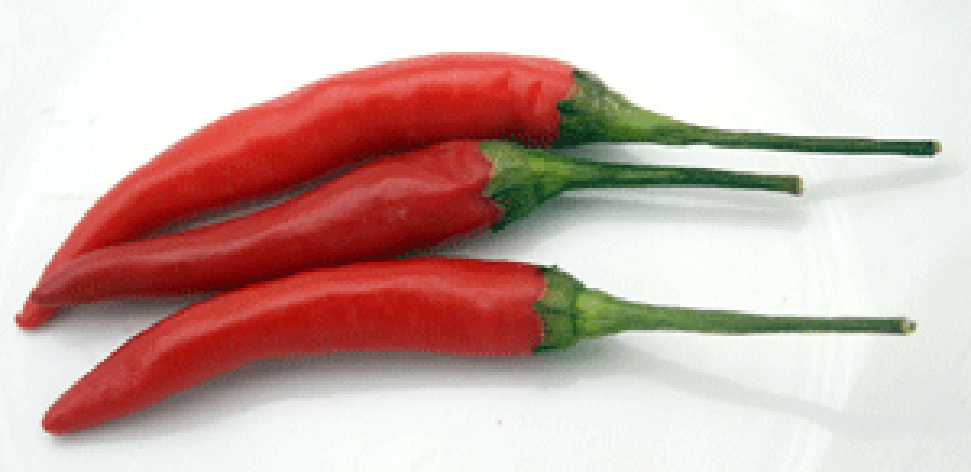 Thai Birdseye Chillis are small, red and quite distinctive in form. Amongst the hottest of the Capsicum annuums they weigh in at 75 000–150 000 Scoville Heat Units and are typical of the cuisine of South East Asia. This is a versatile chilli with an interesting fruity taste and enough heat to make it useful in chillies and curries. |
Capsicum frutescens
As a species Capsicum frutescens contains one of the most economically important chilli peppers; Tabasco which is used by the McIlhenny Company to make tobasco sauce. It also contains the African Bridseye chilli (or Piri-piri) which is a very common foodstuff in West Africa.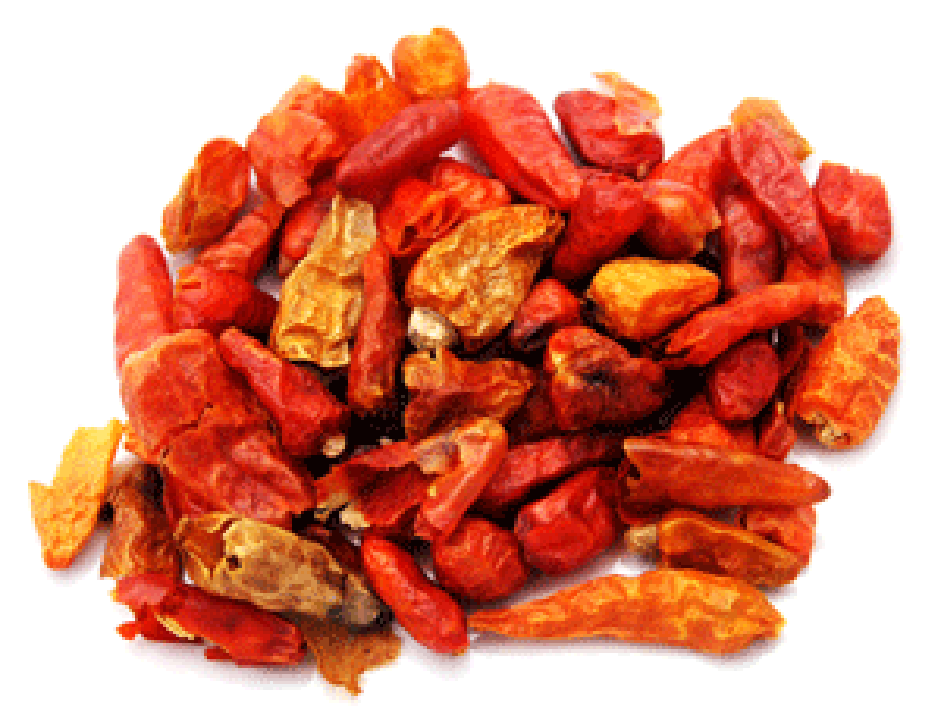 Piri-piri, peri-peri or peli-peli is the name used in Portuguese and a number of African languages to describe the African bird's-eye chilli (which is also known as African Devil and African Red Devil). This is a hot chilli which can score up to 175 000 on the Scoville Heat scale. In Brazil this chilli is known as malagueta. The chilli is very common in West African and Portugese cuisines and is often purchased dry and soaked over night before use. It is generally believed that the Arican bridseye chilli is Capsicum frutescens and is thus a relative of the Tabasco chilli. In West Africa it grows both wild and under cultivation. Along with Scotch Bonned chillies it is one of the components often used in West African 'Hot Pepper Sauce'. It should be noted that piri piri is often sun-dried thus the seeds are viable and it's possible to grow the chilli on your own windowsill from the dried fruit. |
 The Tabasco chilli is the classic example of Capsicum frutescens. A native of Mexico it only has moderate heat (30 000–50 000 Scoville Heat Units) and is most well known due to the sauce produced from it (Tabasco sauce) produced by the McIlhenny Company of Illinois, USA. There are two main types of this pepper, green and red; with the red variety being the most well known. |
Capsicum chinense
The species, Capsicum chinense contains some of the hottest Chilli varieties as determined by the Scoville Heat Scale. This includes Scotch Bonnet and Habanero chillies. This family also probably contains the world's hottest chillies, the Nagas (850 000–1 000 000 Scoville Heat Units) though there is some contention as to whether this is the case as the Nagas contain genes from both Capsicum chinense and Capsicum frutescens (however on a gene-to-gene basis Capsicum chinense genotypes predominate.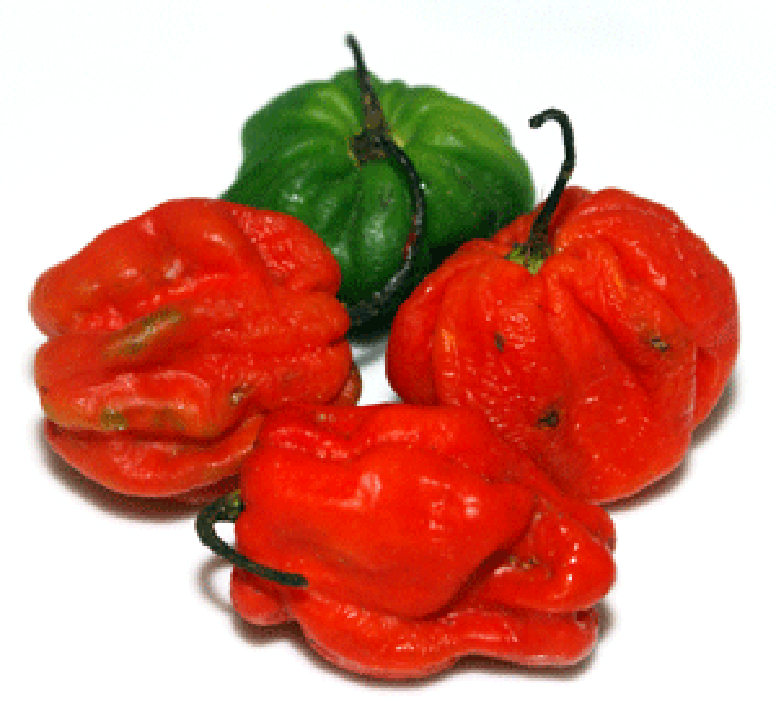 The Scotch Bonnet is a variety of Capsicum chinense of the same species as the habañero pepper. It is an extremely hot pepper measuring 150 000–325 000 on the Scoville Heat Scale. Scotch bonnets are commonly used in the cuisines of the West Indies and West Africa where it's distinct flavour lends dishes like Jerk Spice it's distinctive qualities. It is also an essential ingredient in all West African pepper soups and Hot Pepper Sauce. |
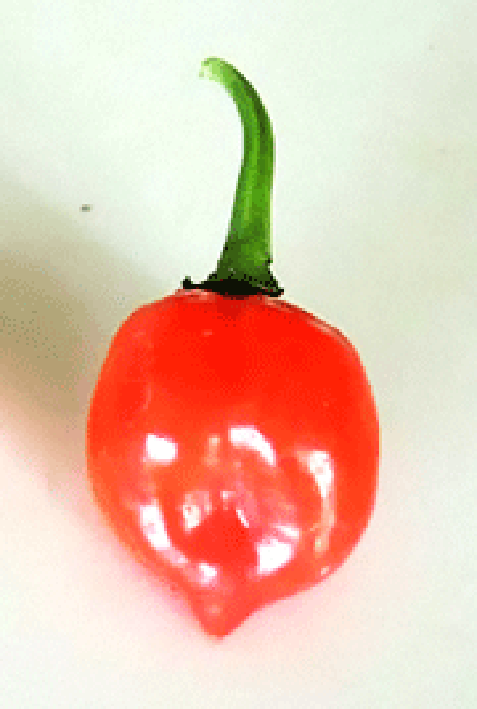 Although it belongs to the same species (Capsicum chinense) as the Scotch Bonnet the Habanero chilli (often misspelled as Habañero) is distinct in form, taste and heat. It looks more like a teardrop in shape and is some 2–6cm long whilst the Scotch Bonnet has a crenellated base and is typicaly larger. In general, Habaneros have a Scoville Heat Rating of between 200 000–300 000 and on average are less hot than Scotch Bonnets, but as Habaneros like sunny climes in places like West Africa the Habanero can be hotter than the Scotch Bonnet (at least it is considered so there) and the Habanero is used for very hot sauces that accompany dry rice dishes. |
Capsicum baccatum
Members of the Capsicum baccatum family tend to have a fruitier flavour than other capsicums and are often ground into colourful powders (green, red, orange, yellow) for use in cooking. Often the cultivar is named after the colour it produces, for example: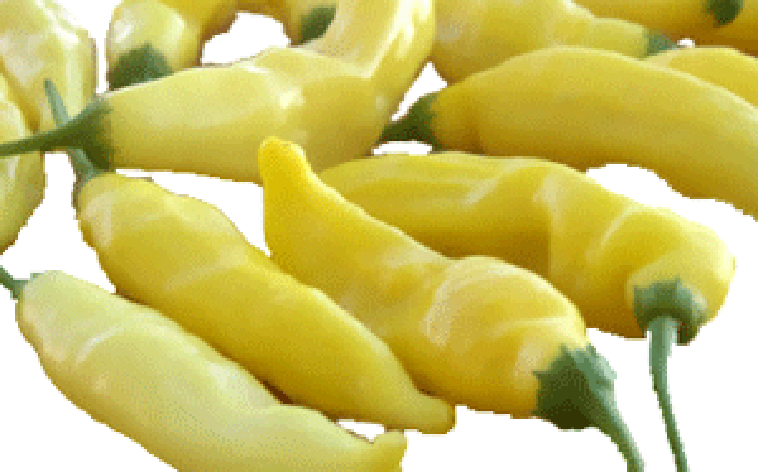 Aji 'Hot Lemon' is an classic example of a Capsicum baccatum cultivar which has a bright yelllow colour and a citrusy aroma. It is not a particularly hot chilli (some 30 000–50 000 Scoville Heat Units) and is predominantly used in the cuisine of Mesoamerica for its colour and flavour. |
Capsicum pubescens
Interestingly evidence shows that Capsicum pubescens ranks amongst the oldest of the domesticated capsicums and is known to have been grown at least 5000 years ago.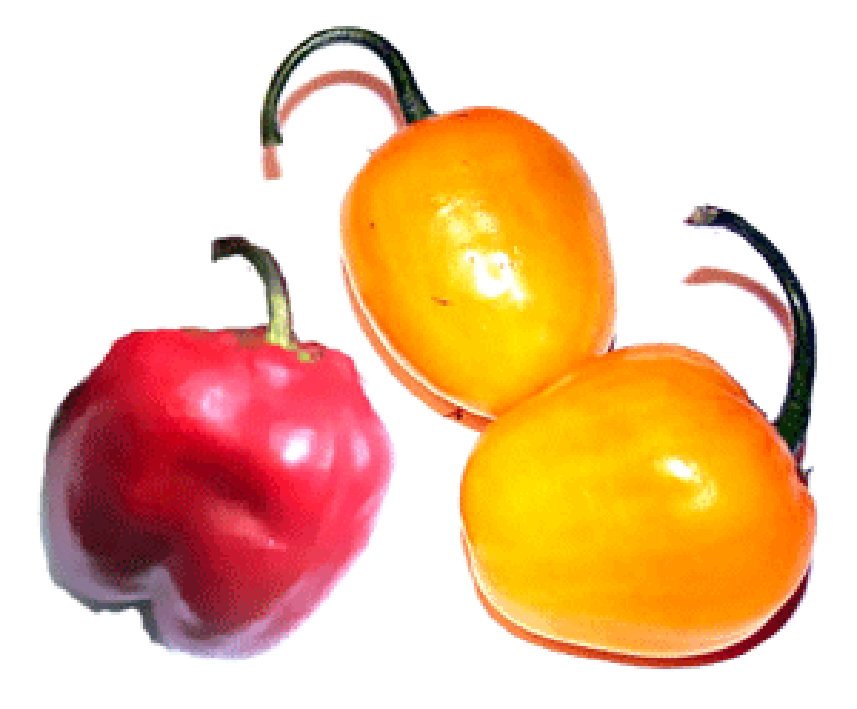 A typical example is the Rocoto chilli which has both red and yellow variants and is of medium to high heat, measuring 50 000–200 000 Scoville Heat Units. The fruit is about 2–3 cm in diameter and is generally egg shaped with black seeds. This is a popular South American variety for stuffing. |
Wild Chillies
In their home regions of Brazil, Bolivia and Argentina, a number of wild chillies are collected and used for cooking. The main varieties being C. praetermissum in Brazil or C cardenasii in Bolivia.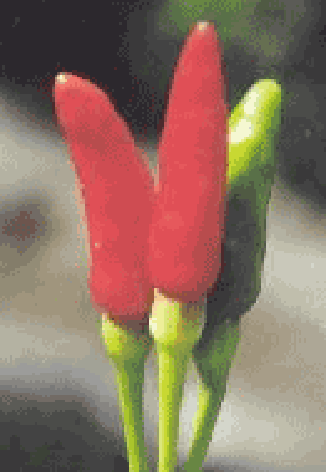 The most well known of these wild chillies is the Brazilian malagueta (a C praetermissum variety. All these wild varieties tend to be small and upright and are very hot (which is why they are sought-after in cooking). Of, course, due to the culinary use of these fruit, there is now some back-yard domestication. Human selection has already begun to produce malagueta chillies with noticeably larger fruit. It will not be long, it seems, before domesticated Brazilian C praetermissum species will rank amongst the world's other domesticated chilli species. |
If you are interested in chillies and the history of this spice, then why not reald my page on the The Global Spread of Chillies from the New World to the Old World. Find out how and why chillies spread from Brazil to Europe, Africa and Asia in just 50 years between 1498 and 1549.
The alphabetical list of all Chilli recipes on this site follows, (limited to 100 recipes per page). There are 2919 recipes in total:
Page 1 of 30
| Ćevapi Origin: Bosnia | Agatoke (Plantain and Vegetable Porridge) Origin: Burundi | Aloo Bharta (Indian Mashed Potatoes) Origin: Anglo-Indian |
| Aad Maas (Goan Pork Rib Curry) Origin: India | Agidi Jollof Origin: Nigeria | Aloo Chaat (Savoury Potato Snack) Origin: India |
| Aadun Origin: Nigeria | Agushi Soup (Ghanaian Egusi Soup) Origin: Ghana | Aloo Dhaniya (Balti Potatoes and Coriander) Origin: India |
| Aaloo Gosht (Mutton Curry with Potatoes) Origin: Pakistan | Ah Mè Thar Hin (Myanmar Beef Curry) Origin: Myanmar | Aloo Gobi Origin: Britain |
| Aam Aur Podina ki Chatni (Mango and Mint Chutney) Origin: India | Ah Mè Thar Hin (Beef Curry) Origin: Myanmar | Aloo Kari (Curried Potatoes) Origin: India |
| Aam Ka Meetha Achaar (Sweet Mango Chutney) Origin: India | Ahlu Hin (Potato Curry) Origin: Myanmar | Aloo ki Bhujia (Pakistani Potato Curry) Origin: Pakistan |
| Acar (Indonesian cucumber pickles) Origin: Indonesia | Ai Manas (Chilli Sauce with Eggs) Origin: East Timor | Aloo Masala (Potato Masala) Origin: India |
| Accras de Morue Origin: French Guiana | Air Fryer Aloo Bread Pakora Origin: Britain | Aloo Muttar Origin: Britain |
| Accras de Morue (Salt Cod Fritters) Origin: Saint Barthelemy | Air Fryer Broccoli Origin: Britain | Aloo Palya (Potato Curry) Origin: India |
| Accras de Morue (Salt Cod Fritters) Origin: Sint Maarten | Air Fryer Couscous Two Ways Origin: Britain | Aloo Paratha (Flatbread with a Spicy Potato Stuffing) Origin: India |
| Accras de Morue (Salt Cod Fritters) Origin: Saint-Martin | Air Fryer Green Banana Plantain Chips Origin: Fusion | Aloo Paratha (Potato-stuffed Paratha) Origin: India |
| Achaari Jhinga (Indian Pickled Prawns) Origin: India | Air Fryer Lamb Koftas Origin: Britain | Aloo Sabzi Kari (Potato Curry) Origin: India |
| Achard de pahua confit (Achard of Confit of Pahua) Origin: Tahiti | Air Fryer Liver and Sausage Curry Origin: Britain | Alu Bhindi (Okra and Potato Curry) Origin: Fiji |
| Achards de Legumes (Vegetable Achards) Origin: New Caledonia | Air Fryer Moroccan Spiced Chicken Wings Origin: Britain | Alu ko Achhar (Potatoes with Split Peas) Origin: Nepal |
| Achards de papaye verte (Green Papaya Pickles) Origin: Mayotte | Air Fryer Omelette Origin: Britain | Alu Tarkari (Potato Curry) Origin: Nepal |
| Achari Masala Origin: India | Air Fryer Sausage Rolls Origin: Britain | Alubias Blancas Con Almejas (White Beans with Clams) Origin: Spain |
| Achari Murgh (Achari Chicken) Origin: Britain | Air Fryer Spicy Pork Belly Origin: Britain | Am Ke Achar (Fijian Mango Pickle) Origin: Fiji |
| Achari Roast Chicken Origin: Pakistan | Air-dried Chillies Origin: Mexico | Amashaza mu gitoke (Peas with Plantains) Origin: Uganda |
| Ackee and Saltfish Origin: Jamaica | Air-fryer Fajitas Origin: Britain | Amb Halad Ka Achar (Zedoary Pickle) Origin: India |
| Ackee Dip Origin: Mexico | Ají Amarillo Paste Origin: Peru | Ambot Tik (Goan Shark Curry) Origin: India |
| Adaka Roti Origin: Sri Lanka | Aji Chombo (Panamanian Hot Sauce) Origin: Panama | Ambotic Origin: Mozambique |
| Adana Kebap Origin: Turkey | Ají de Tamarillo (Ecuadorian Tree Tomato Hot Sauce) Origin: Ecuador | Ambul Thial (Pickled Fish Curry) Origin: Sri Lanka |
| Adobo à la Norteña (Northern-style Adobo Stew) Origin: Peru | Ají Panca Paste Origin: Peru | Ambul Thial (Pickled Fish) Origin: Sri Lanka |
| Adobo Sauce Origin: Mexico | Aji Verde (Spicy Peruvian Green Sauce) Origin: Peru | Ambuyat Tempoyak Origin: Brunei |
| Adobo Valentine Lamb Origin: American | Ajiaco Colombiano (Colombian Ajiaco) Origin: Colombia | American-style Chicken Curry Origin: America |
| Afang Soup Origin: Nigeria | Ajvar (Aubergine and Pepper Dip) Origin: Serbia | Amiwo au Poulet 2 (Amiwo with Chicken) Origin: Benin |
| Afghan Kofta Curry Origin: Afghanistan | Albóndigas de Sardinas (Sardine Meatballs) Origin: Equatorial Guinea | Amok Trey Khmer (Cambodian Fish Amok) Origin: Cambodia |
| Afghani Chicken Curry Origin: Pakistan | Alitas de pollo picante (Spicy Chicken Wings) Origin: Ecuador | Amritsar Fish and Chips Origin: India |
| African Chicken (Macanese One-pan Chicken Curry) Origin: Macau | Alitcha Birsen Origin: Eritrea | Anadl y Ddraig (Dragon's Breath) Origin: Welsh |
| African Fish Curry Powder Origin: West Africa | Alleppey Fish Curry Origin: India | Anardana Gosht (Lamb Curry with Pomegranate) Origin: India |
| African Hot Sauce Origin: sub-Saharan Africa | Almogrote Gomero (Cheese and Tomato Paste) Origin: Spain | Anardana Jheenga (Pomegranate-flavoured Prawns) Origin: India |
| African Stew Curry Powder Origin: West Africa | Aloo Anardana Origin: India | Anardana Pakora in Mustard Oil Origin: India |
| African-style Barbecue Sauce Origin: African Fusion | Aloo Badun (Potato Badun) Origin: Sri Lanka | |
| Afrikaanse Yakhni Origin: South Africa | Aloo Bhaji Origin: India |
Page 1 of 30